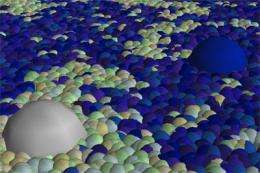Proteins feel long-range attractive forces

(Phys.org)—Proteins embedded in the lipid membranes of cells feel long-range attractive forces in specific patterns that mediate the proteins' behavior—for example, assisting in the clumping sequences in response to allergens, such as pollen, that eventually lead to the inevitable sneeze.
Cornell physicists have identified the physical mechanisms behind these protein attractions, which are set off by changes in cellular membranes. Their research, led by professor of physics Jim Sethna, has been accepted for publication in Physical Review Letters.
The researchers were inspired by a recent discovery that cell membranes can separate into two liquid phases, much like oil and water, in fractal-like patterns. The physical fluctuations that result lead to remarkably long-range attractions between certain proteins, depending on the fractal patterns.
These changes take place at the so-called critical point of the liquid-liquid phase separation of the cell membrane, which is the subtle temperature and composition point at which the two phases separate. The proteins sitting in this membrane, at this critical point, are able to feel forces 20 nanometers apart, the physicists predict—a notable distance at those scales.
"We were intrigued that it seems like biology does want to tune itself closely to this critical point," said graduate student and co-author Ben Machta.
The experiments built on previous work by former postdoctoral associate and co-author Sarah Veatch, who had studied cellular membranes of immune cells and demonstrated their liquid-liquid phase separations.
The work was supported by the National Science Foundation and the National Institutes of Health.
Journal information: Physical Review Letters
Provided by Cornell University




















